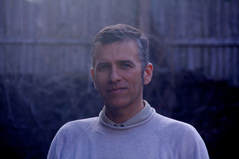The River Was Deep
|
I love the outdoors, yet I am not so outdoorsy that I would want to kayak up an Alaskan river, or even to read about someone who had—or so I thought before reading Lava Falls, the latest collection from Lucy Jane Bledsoe. Given the author’s bio—name-checking physical exertions in the Grand Canyon, Yellowstone, Alaska, and Antarctica—somehow I feared these 11 stories and one novella would be vigorously good for the reader, like exercising outside at six in the morning in the middle of winter. I wasn’t prepared for how engagingly Bledsoe would write about the physicality of being in the wild. The thing that really struck me afterward, though, is the breadth of this collection. Each story was different from the one that preceded it. Different characters (with different sexual orientations); different struggles; different settings; different themes.
Many of the narrators and characters are in mid life: 50 and up. There is a weariness in their voices, and a longing, but something placid as well. Some understanding of the self has, at last, been attained. “Everyone relaxes when a woman reaches a certain age, and I find that very relaxing myself,” says the narrator in “Poker.” The stories aren’t always told in the first person, but when they are, as this one is, the narrator is often speaking to herself. Here she does that by mentally addressing an old lover. While there isn’t much outward drama in the story, the relative physical isolation of being “on the ice” in Antarctica heightens the wayward inner feelings. The writing throughout this collection is direct and the overall tone is unaffected and admirably plain. In “Wildcat,” a blind grandfather and his grandson hunt the animal that’s been stalking their suburban neighborhood. Reviewing the strained relationship with his daughter, the grandfather understands that “Years were like sand. They slid and dispersed. You couldn’t pick them back up again.” This understated narrative quality nicely highlights Bledsoe’s subtle touches of beauty. In “The Antarctic,” two spinsterish sisters squabble about taking a cruise to the South Pole. Bledsoe describes the pivotal moment that they fight as “when the sky was flat and gray, and only a few red apples hung hard and near-frozen from the tree in the backyard.” Then again, in a story like “Skylark,” about a talented teenage singer who runs away from home to discover her sexuality and find her voice, Bledsoe gets hold of her conceit like a dog with a tennis ball in its mouth, who noses you with it, yet won’t let go, and you wind up with slobber all over your leg. She does the same thing in “Life Drawing” and “The End of Jesus.” Both focus on the strangling chokehold of a Christian fundamentalist upbringing. Ironically, the “message” of these stories is obvious to the point of sermonizing. “The confusing thing about returning to a place that so warped your existence is that you simultaneously can’t believe you’ve let it have so much power over you even as it exerts its force all over again,” the latter story’s narrator realizes at the start. But there are no further surprises for the reader. I would have welcomed more nuance, and for at least one of the stories to offer a different take on things. |
The thing that really struck me afterward, though, is the breadth of this collection. Each story was different from the one that preceded it. Different characters (with different sexual orientations); different struggles; different settings; different themes. The title story, the novella, concerns a group of intergenerational women who see ghosts from both the past and future on their Grand Canyon rafting trip. Set in a dystopian near-future, what’s most terrifying is how ominous their present time—so close to our country’s present moment—reveals itself to be.
Unfortunately, the six main characters—names, ages, careers, relationships to one another—are all lumped together in one paragraph. It’s like being at a cocktail party where you’re introduced to everyone in the room at once. Wait, who’s Paige? Which one’s Kara? Mark that paragraph because you’ll need to come back to it. Is the novella not long enough for the characters to be introduced gradually? Or is Bledsoe just in a hurry to plop everyone in the boats and head on down the river? There’s another couple in another boat, and something isn’t right about them, but the suspense doesn’t build. The action is confused and even the dialogue suffers in the end: too much exposition and speech-making. It’s especially a shame because the germ of this story is such a good one. It needed room to develop and grow. That said, I can definitely see this as a movie. And oddly, the cover of this book shows a young woman underwater in a flowing white dress. The characters are nowhere near as fanciful as this image would suggest. They’re out in kayaks, in boats, in tents, on banks of ice. I see them in anoraks, in shorts and sports bras and tank tops and Teva sandals. In none of the stories does anyone dressed like this Ophelia appear. I don’t understand this choice. It’s confusing, and I really hope Bledsoe doesn’t lose readers because of this. (Anyone drawn to this book because of the cover is bound to be disappointed, or at least confused.) Overall, though, the spare writing and subtle tonal shifts throughout make for a satisfying, varied collection. The final story, “The We of Me”—dedicated “with thanks” to Carson McCullers—is incredibly charming and comes off almost like a throwaway. It’s much more bonkers than the rest. I’d be happy if this was a direction Bledsoe decides to paddle in for her next collection. |

REVIEWED BY MASTER MICHAEL QUINN
Master Michael Quinn writes personal essays and has created performance pieces with many of them, reading the stories aloud and “illustrating” them not with pictures but with songs. Performances include Bedridden, Last Call, Boo, Kiss & Tell, My Valentine, and Blue Illusion. More about his work can be found at mastermichaelquinn.com.
Master Michael Quinn writes personal essays and has created performance pieces with many of them, reading the stories aloud and “illustrating” them not with pictures but with songs. Performances include Bedridden, Last Call, Boo, Kiss & Tell, My Valentine, and Blue Illusion. More about his work can be found at mastermichaelquinn.com.
